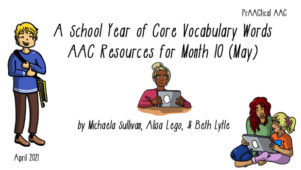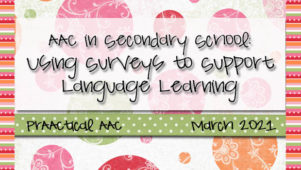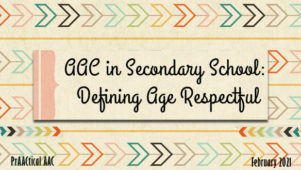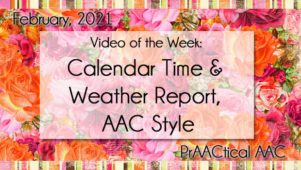AAC in Secondary School: Research Project AACtivity
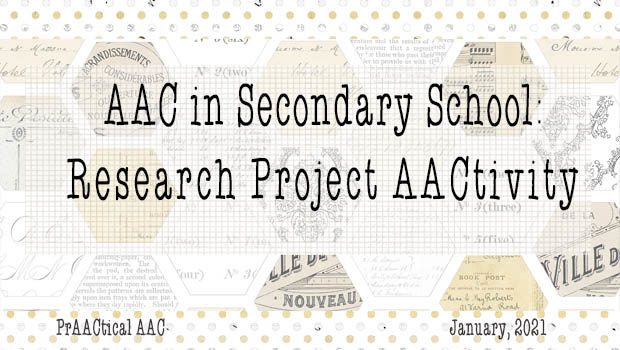
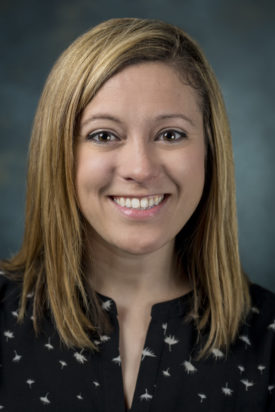 We’re excited to start off 2021 with a new series focusing on supporting students who use AAC during their high school years. AAC SLP Ashley Larisey is the guest author for the AAC in Secondary School series which will have ideas for specific activities in some months and articles on issues pertinent to secondary school AAC in others.
We’re excited to start off 2021 with a new series focusing on supporting students who use AAC during their high school years. AAC SLP Ashley Larisey is the guest author for the AAC in Secondary School series which will have ideas for specific activities in some months and articles on issues pertinent to secondary school AAC in others.
Ashley is an SLP at Community High School District 218 in Oak Lawn, Illinois. She is also an Adjunct Clinical Supervisor and Instructor at Saint Xavier University.
::::::::::::::::::::::::::::::::::::::::::::::::::::::::::::::::::::::::::::::::::::::::::::::::::::::::::::::::::::::::
Introduction to the Series: AAC for Secondary Students
Some of the most common questions that I hear from my SLP colleagues are specific to AAC treatment planning and implementation. As a high school AAC SLP, I am privileged to have the opportunity to work with students as they prepare and transition into adulthood. I often find that many SLPs are looking to provide their students with functional, age-respectful, and engaging activities. However, examples of these activities can be difficult to find and even harder to replicate for students with a wide range of needs. In this series, I hope to provide real-life examples of activities that increase student engagement, are rich in opportunities for eliciting language, age-respectful, and able to be adapted for any student who uses AAC on your caseload.
Research Projects
Research projects are a great way to elicit language with AAC users while providing opportunities to each of the four communicative competencies as set forth by Janice Light (1989). The four competencies (operational, linguistic, social, strategic) are important both individually and as a whole in the development of communication for individuals who use AAC. “In order to achieve communicative competence, individuals using AAC systems must integrate their knowledge, judgment, and skills in each of these four areas. Developing skills in only one or two of these areas is not functional for any individual” (Light, 1989). The use of dynamic activities can help with the integration of the four communicative competencies, as they rarely (if ever) stand-alone within communicative interactions.
When examining the different areas of communicative competence, I find it very useful to use the *Dynamic AAC Goals Grid (DAGG-2) and the Ability Level Continuum ( Vicki Clarke & Holly Schneider via Tobii-Dynavox) as a guide for differentiation and scaffolding. These tools use the framework of communicative competencies and identify different skill sets that could be targeted within different ability levels. These two tools can provide support in determining how to adapt an activity for a group of students with various complex communication needs.
So, let’s dive into the activity: completing a research project!
Choosing Your Topic
When selecting the topic of the research project, it is important to involve your student in the decision making process. This is their project – what do they want to learn more about? Your research topic can be identified through curricular content, high-interest topics, or current events. Brainstorming can be used to develop possible ideas for research and is a great way to activate prior knowledge and generate interest. The example below was a research project designed around 20,000 Leagues Under the Sea from Readtopia. Student choices ranged depending on personal preferences and individual areas of interest.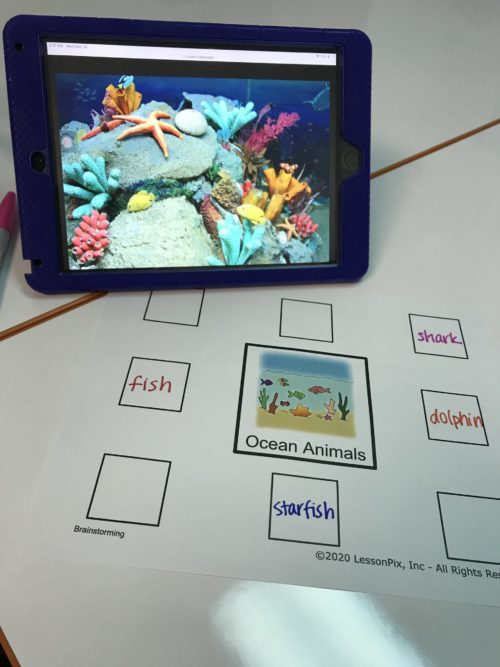
Another option would be to explore a topic of high interest. This can be an excellent way to introduce the concept of research and searching for information. When using a motivating topic, it is likely that your student already has some background knowledge that they could contribute to the project. This prior knowledge will create a bridge between what they already know with what they hope to learn through inquiry. Some examples could include researching a favorite actor, athlete, or event.
Predictable Chart Writing can be used to embed literacy if the activity is being done as a group. Students can insert their fill-in into the chart for their topic and the chart can be reviewed while the additional research components are completed across several days/sessions.
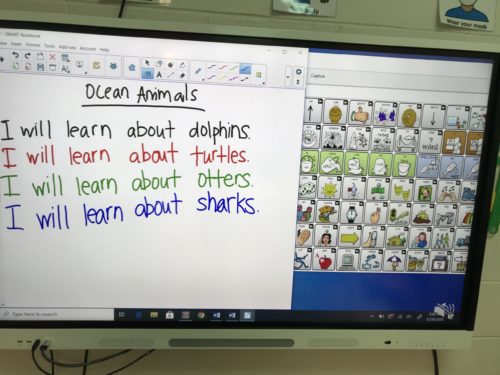
Gathering Information About Your Topic
Formulating questions to learn more about a topic is engaging, motivating, and full of language and literacy! The way that questions are formulated and how information is obtained will look different depending on the profile of your learner.
Use of a graphic organizer with target questions can be useful to help structure the activity. For example, *this worksheet was used as a template for the aforementioned ocean animals activity. Descriptive teaching (Gail Van Tatenhove) was used to explain some of the vocabulary when generating questions regarding the topic. When “using a descriptive style, the teacher mentions and references the context-specific words, then teaches concepts behind the words using high-frequency, re-usable, common words” (Van Tatenhove 2009). For example, the word “diet” is a vocabulary word that we may not see pre-programmed into a communication device. However, is there a way that the word can be described using core vocabulary? In the example below, “eat” was paired with “diet”, “illustration” with “draw”, and “appearance” with “look.” Descriptive teaching can be useful in a) increasing receptive vocabulary by using high-frequency words to define a term, and b) providing expressive language support to describe the vocabulary word while literacy skills continue to develop. It is impossible to have every word pre-programmed into a communication device due to limitations in space, or “AAC real estate.” It is essential that literacy is targeted with all students to help support their ability to read, write, and spell, as this allows them greater communicative independence.
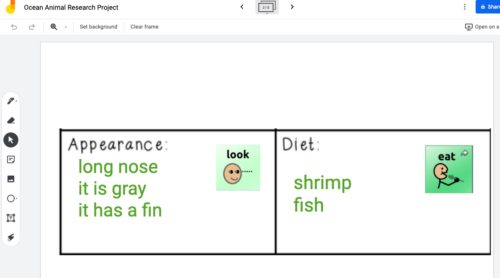
Examples of descriptive teaching materials used for an ocean animals research project in Jamboard
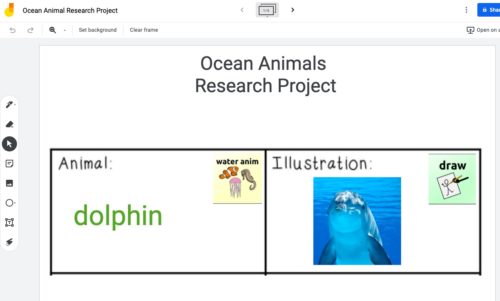
KWL (know, want to know, has learned) charts can also be very beneficial to provide a framework for research when students are exploring a topic in which they already have some prior knowledge. When identifying what students already know or want to know, tools such as the Expanding Expression Tool (EET) can help learners develop their own questions.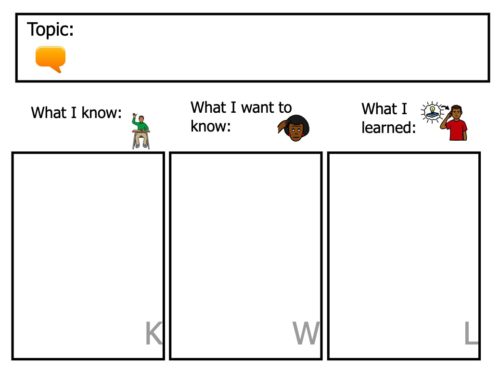
Many AAC apps and devices now have built-in tools that will take the questions that have been generated to either a) open a search engine to look for information about the topic, or b) use virtual assistants (Alexa, Google Home, Siri) to ask questions.
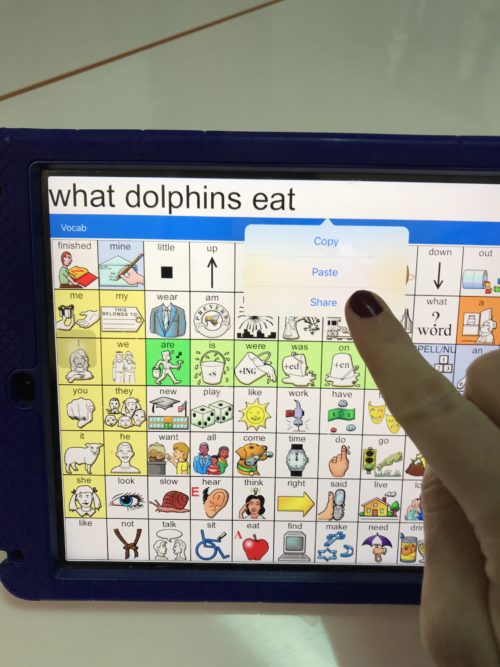
Example: Sending a text from the message bar to open an external app to search for information
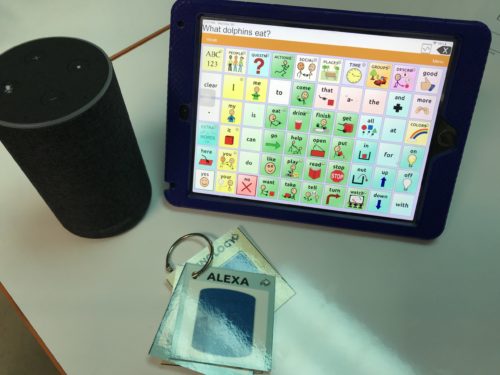
Image of Alexa with the question “What dolphins eat?” in the message bar.
Outside of the educational environment, motivation/engagement, and student preferences when looking for information for the project. Providing autonomy allows for the learner to identify the tools/strategies that will be most beneficial for them as they transition towards adulthood.
When searching for information about your topic, you can use search engine capabilities as described above to get answers to specific questions, like where a person was born or information about the habitat of an animal. However, books and videos can also provide detailed information about the topic that could be included in the final presentation. Once the topic is selected, you can search to see if there are any other forms of media available that might help to provide more information surrounding your topic. These can be reviewed together to find additional information or “fun facts” to include in the project.
Design Your Project
You can use a variety of different tools when designing the project as part of a presentation. First, consider how your students will be presenting. Will they be presenting to the class? Will they be designing poster presentations? Can they use apps like Pictello/Story Creator or presentation software like Google Docs or Powerpoint? When selecting apps or software, it can be beneficial to use what works best for your setting and is the most functional for your student. Selecting tools that are universally used across a program (when appropriate) can help to support carryover between classrooms and other settings.
There are tons of options for customization when it comes to project design! Provide your student to select color preferences, photos or GIFs to include for images, and images to include. Writing can be embedded into this portion of the activity for students who are either conventional or emergent literacy learners.
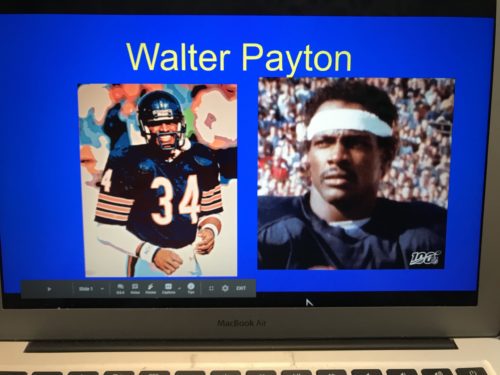
Title slide of a presentation about a student-directed topic of choice for a famous person.
Presentations are a great way for students to work on expressive language skills by sharing the in-depth information they obtained through research with the group or class. It can also provide other students with the opportunity to think critically about the information and ask questions to the presenter.
Co-planned scripts (Dr. Caroline Musselwhite, Linda Burkhart) can be used to support emergent communicators actively participate in presentations to the class. These scripts are co-constructed with student to help them use social and/or narrative language skills to communicate with others. The visual supports that were used to develop research questions can be used to plan the scripts that will be used during the presentation. Here is one example of a co-planned script for a research project about dolphins.
- “Hey everybody!”
- “Are you all ready to learn about dolphins?”
- “You’re never going to believe what I learned.”
- “Does anyone know what they eat?”
“Go ahead and take a guess.” - “They actually eat fish, shrimp, AND squids!”
- “Isn’t that so disgusting!! BLECH.”
- “Wanna hear a fun fact?”
“They have TWO stomachs!” - “I wish I had two stomachs, I’d eat a lot of cookies.”
- “What would you eat?”
- “So, that’s about it! Thanks for listening!”
Notice that not all information obtained from research was included in the script. That is ok! This will vary depending on your learner.
Recasting is another useful strategy to use when working with students who present with language that is telegraphic in nature. If your student provides 1-2 word responses for information to be presented to the class, use recasting to add complexity to language like morphology and syntax. If this is being co-constructed as part of a script, 1) be sure not to change the original meaning of the message in your recast and 2) check with your learner following your recast to be sure that the information is what your learner would like to include in the presentation. Asking things like “Does that sound right?” or “Is there anything you want to change?” helps to honor the individuality of the message while still providing a grammatically correct model for expansion.
Scripts can be programmed into sequential voice output devices or programmed into specific sections that are designated for storytelling and scripts with an AAC app or device.
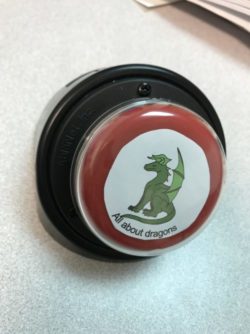
Example of a sequential voice output AAC device
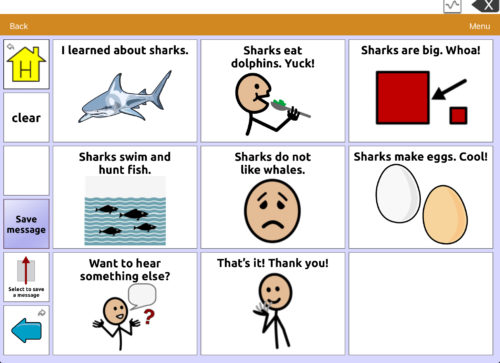
Example of a page within “stories and scripts” on TouchChat programmed for a short research project presentation.
Most importantly – make the presentation fun! Much of the learning, aided language stimulation, recasting, and communication opportunities have happened already in the previous steps. This is truly about the process, not the product. When we put too much pressure on “performance” in the final presentation, we risk losing student engagement by turning the activity into a test. It doesn’t have to be perfect! I would encourage dressing up in character or adding fun slides, video clips, or filters (useful for remote learning) to any accompanying media presentations.
Be sure to join me next month as I share more resources, strategies, and tips for working with high school and post-secondary students who use AAC! You can follow me on Instagram at @mrs.larisey for more therapy tips and treatment ideas.
References:
Light, J. (1989). Toward a definition of communicative competence for individuals using augmentative and alternative communication systems, Augmentative and Alternative Communication, 5:2, 137-144, DOI: 10.1080/07434618912331275126
Van Tatenhove, G. (2009). Building Language Competence with Students Using AAC Devices: Six Challenges. Perspectives on Augmentative and Alternative Communication, 18(2), 38-47.
Resources
- DAGG-2
- Adapted worksheet from Ripleys Reliable Resources
- Readtopia – Don Johnston
- Expanding Expression Tool
- Co-Planned Social Scripts presentation and handout
About the Series Author
Ashley Larisey is an SLP at Community High School District 218 in Oak Lawn, Illinois. She is also an Adjunct Clinical Supervisor and Instructor at Saint Xavier University. Ashley shares AAC content on Instagram at @mrs.larisey.
You can learn more from Ashley here.
Filed under: Featured Posts, PrAACtical Thinking
Tagged With: education, school
This post was written by Carole Zangari

